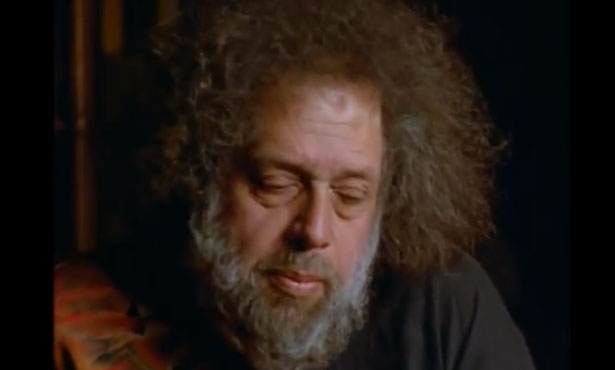
Marshall Berman. (Courtesy Youtube user Patell and Waterman’s History of New York)
In the summer of 1987, I went to Brazil for the first time to give a talk at a big conference in São Paulo. Although the local papers covered the event, their cultural pages were devoted to another—the book tour of Marshall Berman, there to discuss his masterpiece, All That Is Solid Melts Into Air: The Experience of Modernity, published in 1982. I remember being amazed and full of admiration at all the ink being devoted to a literary event by the mass media. Wherever people were reading newspapers—in cafés, on buses, on the street—there was Marshall’s full-page face.
Marshall’s great subject, not only in that book but also throughout the nearly fifty years he devoted to writing and to teaching at City College, was the production of modern people and the contexts and conditions that offer them the powers and possibilities for finding and distinguishing their private and public destinies. For Marshall, the primal scene for this self-development was always the city, and no one has been more loving or lucid in his depiction, criticism and celebration of urbanity. The bright illumination where modernity dwells is not limited to the city’s sidewalks or subways, its girders or grids, but can encompass all the tools of consciousness with which cities are both constructed and understood. As an observer, theorist, critic, and lover, Marshall’s analytical ambit was indeed grand, embracing with equal incisiveness, originality and nuance the Grand Concourse, Grand Central, the Grand Inquisitor and Grand Narratives.
After the conference in Brazil, a few of us decided to visit that Mecca of modernity, Brasĩlia. As we stood at the front desk waiting to deposit our passports in the hotel safe, we noticed that Marshall’s name preceded ours on the sign-in list. Sensing the ink was fresh, we turned and spotted him across the lobby and introduced ourselves. He was suffering one of modernity’s characteristic inconveniences: the airline had lost his luggage. Fortunately, Marshall was able to overcome the sartorial challenge of being without a change of clothes—if anyone would look apt in a bed sheet toga, it was Marshall, the Socrates of Hamilton Heights, the Manhattan neighborhood where he taught for so long—and he shuffled off to the next leg of his victory lap.
Several months ago, I couldn’t find my battered copy of All That Is Solid Melts Into Air and ordered another. What arrived was a more recent edition, and it had a new preface that evoked, to my delight, the Brazilian trip. Brasĩlia had been Marshall’s first stop, and he described the place as the antithesis of the kind of urban form and culture he held most dear. Marshall famously wrote about his transformative youthful discovery of the young Marx, conveying not simply the deep relevance of Marxian analysis for the city but its fundamental humanity and connection to an indispensably ethical happiness. He returned to a phrase of Marx’s that was also his own credo and goad: “The free development of each is the condition of the free development of all.” In Brasĩlia, a dogmatic idea of order—the brutalism of concrete, glass, and vast windswept spaces—obliterates the kinds of intimacy and diversity that truly conduce public engagement in a city. Marshall’s trip became a conversation with Brasĩlia and the architect of many of its buildings, Oscar Niemeyer, in which Marshall argued, as he did so lucidly for so long, for a dialogic, not a deterministic vision of urban form and life, for a city of expansive opportunities and encounters.
Last month I spent a day in Athens. Walking through the Plaka to a rooftop restaurant with a panoramic view of the Acropolis, I passed along a street lined on one side with al fresco diners and on the other with a public transit line. Beyond the tracks lay the remains of the agora. The section drawn through these three conditions—in both their cooperation and antagonism—was pure Marshall. Here were three visions of public interaction—ideal types of urban pleasure, mobility and governance—that represented 2,500 years of work on the project of giving shape to urbanity and to producing the habits of citizenship that give it life.
Whenever we visit such places, we’ll always have Marshall with us. We’ll sense how graffiti denouncing the interventions of the Troika in the contested politics of Greece would have sparked his fascination and solidarity. We’ll feel his delight when we hear the sounds of Hellenic hip-hop played in the street and long for him to trace its genealogical tributaries back to its source in the Bronx, where he was born and which always remained both his spiritual home and a barometer of the conditions of modern urban life. We’ll know how the slow ambling of crowds of people from all over the world would have sparked his joy in the collusion of difference that only cities can induce. We’ll wonder at how the rumbling train in its cutting might have sparked reflections on the ruinous trench dug through the Tremont neighborhood of his childhood to clear a path for a freeway. And we’ll thrill in the way the proximity of the agora—the true locus classicus of so much he held dear—would have quickened his heart, recalled conversations with his ancient contemporaries Plato and Aristotle. In his remarkable writing, his wonderful teaching and the sweet emanations of his great spirit, Marshall Berman led us all towards this dream of freedom for the city and ourselves.


